The Cambridge History of China. Vol. 12: Republican China, 1912-1949, Part 1
Подождите немного. Документ загружается.

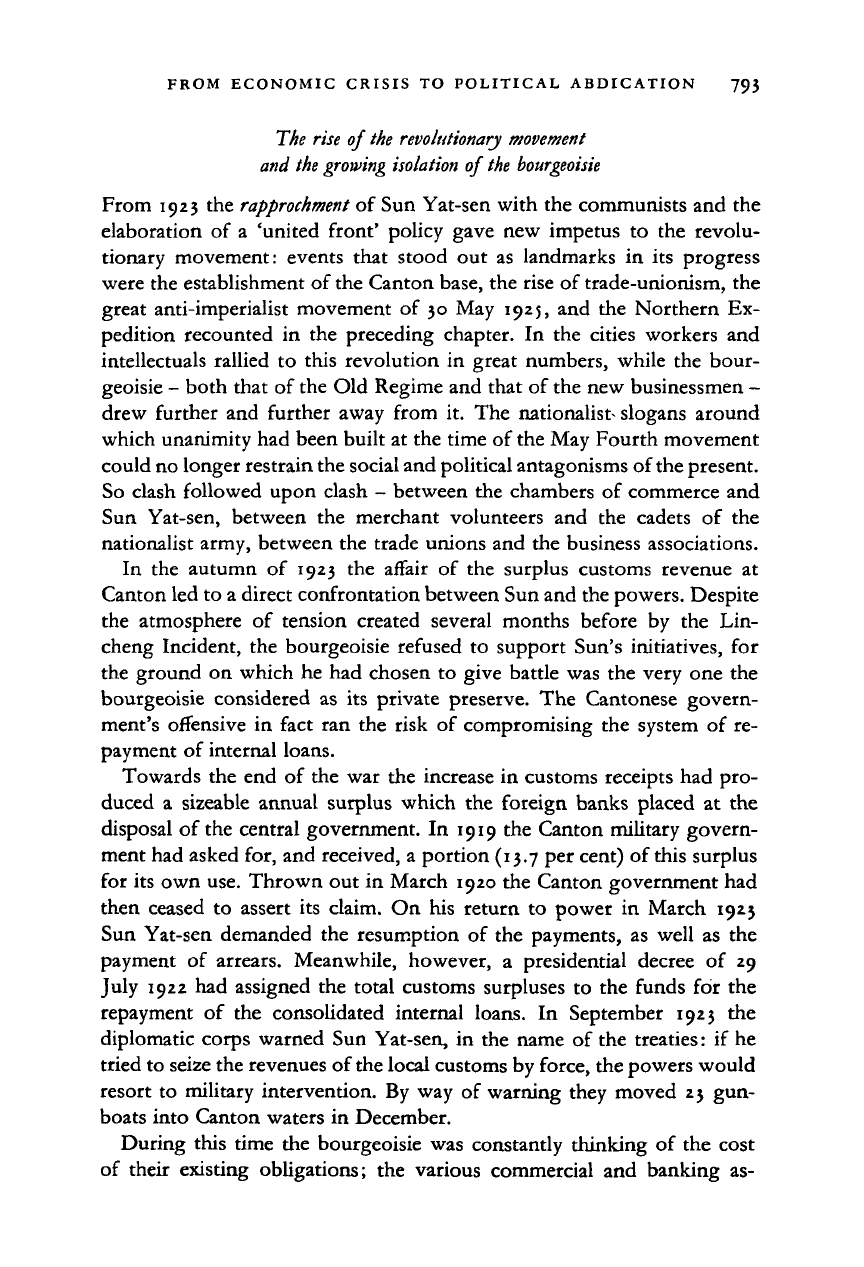
FROM ECONOMIC CRISIS TO POLITICAL ABDICATION 793
The rise of
the revolutionary
movement
and
the growing
isolation of
the bourgeoisie
From 1923 the
rapprochment
of Sun Yat-sen with the communists and the
elaboration of a 'united front' policy gave new impetus to the revolu-
tionary movement: events that stood out as landmarks in its progress
were the establishment of the Canton base, the rise of trade-unionism, the
great anti-imperialist movement of 30 May 1925, and the Northern Ex-
pedition recounted in the preceding chapter. In the cities workers and
intellectuals rallied to this revolution in great numbers, while the bour-
geoisie - both that of the Old Regime and that of the new businessmen -
drew further and further away from it. The nationalist-slogans around
which unanimity had been built at the time of the May Fourth movement
could no longer restrain the social and political antagonisms of the present.
So clash followed upon clash - between the chambers of commerce and
Sun Yat-sen, between the merchant volunteers and the cadets of the
nationalist army, between the trade unions and the business associations.
In the autumn of 1923 the affair of the surplus customs revenue at
Canton led to a direct confrontation between Sun and the powers. Despite
the atmosphere of tension created several months before by the Lin-
cheng Incident, the bourgeoisie refused to support Sun's initiatives, for
the ground on which he had chosen to give battle was the very one the
bourgeoisie considered as its private preserve. The Cantonese govern-
ment's offensive in fact ran the risk of compromising the system of re-
payment of internal loans.
Towards the end of the war the increase in customs receipts had pro-
duced a sizeable annual surplus which the foreign banks placed at the
disposal of the central government. In 1919 the Canton military govern-
ment had asked for, and received, a portion (13.7 per cent) of this surplus
for its own use. Thrown out in March 1920 the Canton government had
then ceased to assert its claim. On his return to power in March 1923
Sun Yat-sen demanded the resumption of the payments, as well as the
payment of arrears. Meanwhile, however, a presidential decree of 29
July 1922 had assigned the total customs surpluses to the funds for the
repayment of the consolidated internal loans. In September 1923 the
diplomatic corps warned Sun Yat-sen, in the name of the treaties: if he
tried to seize the revenues of
the
local customs by force, the powers would
resort to military intervention. By way of warning they moved 23 gun-
boats into Canton waters in December.
During this time the bourgeoisie was constantly thinking of the cost
of their existing obligations; the various commercial and banking as-
Cambridge Histories Online © Cambridge University Press, 2008
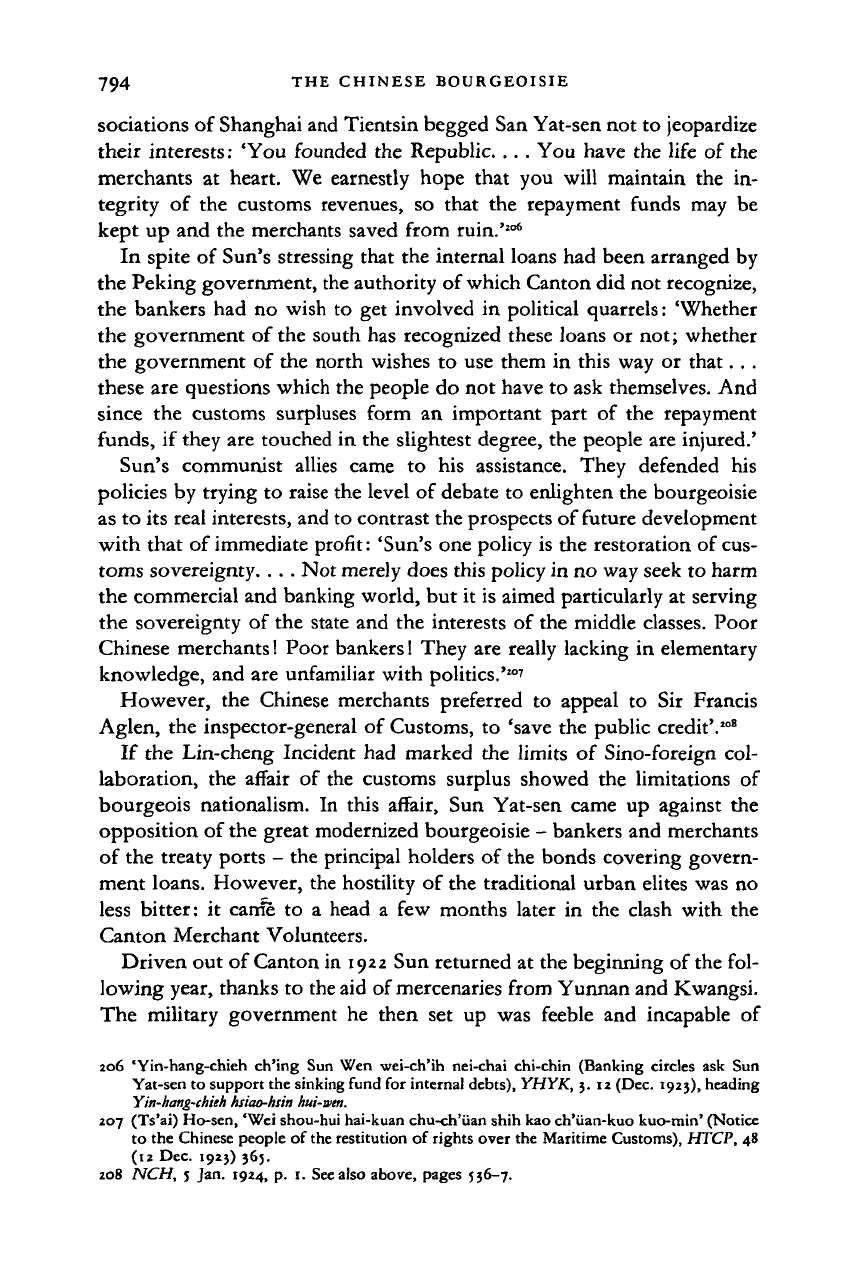
794 THE CHINESE BOURGEOISIE
sociations of Shanghai and Tientsin begged San Yat-sen not to jeopardize
their interests: 'You founded the Republic. . . . You have the life of the
merchants at heart. We earnestly hope that you will maintain the in-
tegrity of the customs revenues, so that the repayment funds may be
kept up and the merchants saved from ruin.'
206
In spite of Sun's stressing that the internal loans had been arranged by
the Peking government, the authority of which Canton did not recognize,
the bankers had no wish to get involved in political quarrels: 'Whether
the government of the south has recognized these loans or not; whether
the government of the north wishes to use them in this way or that. . .
these are questions which the people do not have to ask themselves. And
since the customs surpluses form an important part of the repayment
funds,
if they are touched in the slightest degree, the people are injured.'
Sun's communist allies came to his assistance. They defended his
policies by trying to raise the level of debate to enlighten the bourgeoisie
as to its real interests, and to contrast the prospects of future development
with that of immediate profit: 'Sun's one policy is the restoration of cus-
toms sovereignty. . . . Not merely does this policy in no way seek to harm
the commercial and banking world, but it is aimed particularly at serving
the sovereignty of the state and the interests of the middle classes. Poor
Chinese merchants! Poor bankers! They are really lacking in elementary
knowledge, and are unfamiliar with politics.'
207
However, the Chinese merchants preferred to appeal to Sir Francis
Aglen, the inspector-general of Customs, to 'save the public credit'.
208
If the Lin-cheng Incident had marked the limits of Sino-foreign col-
laboration, the affair of the customs surplus showed the limitations of
bourgeois nationalism. In this affair, Sun Yat-sen came up against the
opposition of the great modernized bourgeoisie - bankers and merchants
of the treaty ports - the principal holders of the bonds covering govern-
ment loans. However, the hostility of the traditional urban elites was no
less bitter: it carrie to a head a few months later in the clash with the
Canton Merchant Volunteers.
Driven out of Canton in 1922 Sun returned at the beginning of the fol-
lowing year, thanks to the aid of mercenaries from Yunnan and Kwangsi.
The military government he then set up was feeble and incapable of
206 'Yin-hang-chieh ch'ing Sun Wen wei-ch'ih nei-chai chi-chin (Banking circles ask Sun
Yat-sen to support the sinking fund for internal debts),
YHYK,
3.12 (Dec. 1925), heading
Yin-hang-chieh hsiao-hsin
hui-wtn.
207 (Ts'ai) Ho-sen, 'Wei shou-hui hai-kuan chu-ch'uan shih kao ch'iian-kuo kuo-min' (Notice
to the Chinese people of the restitution of rights over the Maritime Customs), HTCP, 48
(12 Dec. 1923) 365.
208 NCH, j Jan. 1924, p. 1. See also above, pages 536-7.
Cambridge Histories Online © Cambridge University Press, 2008
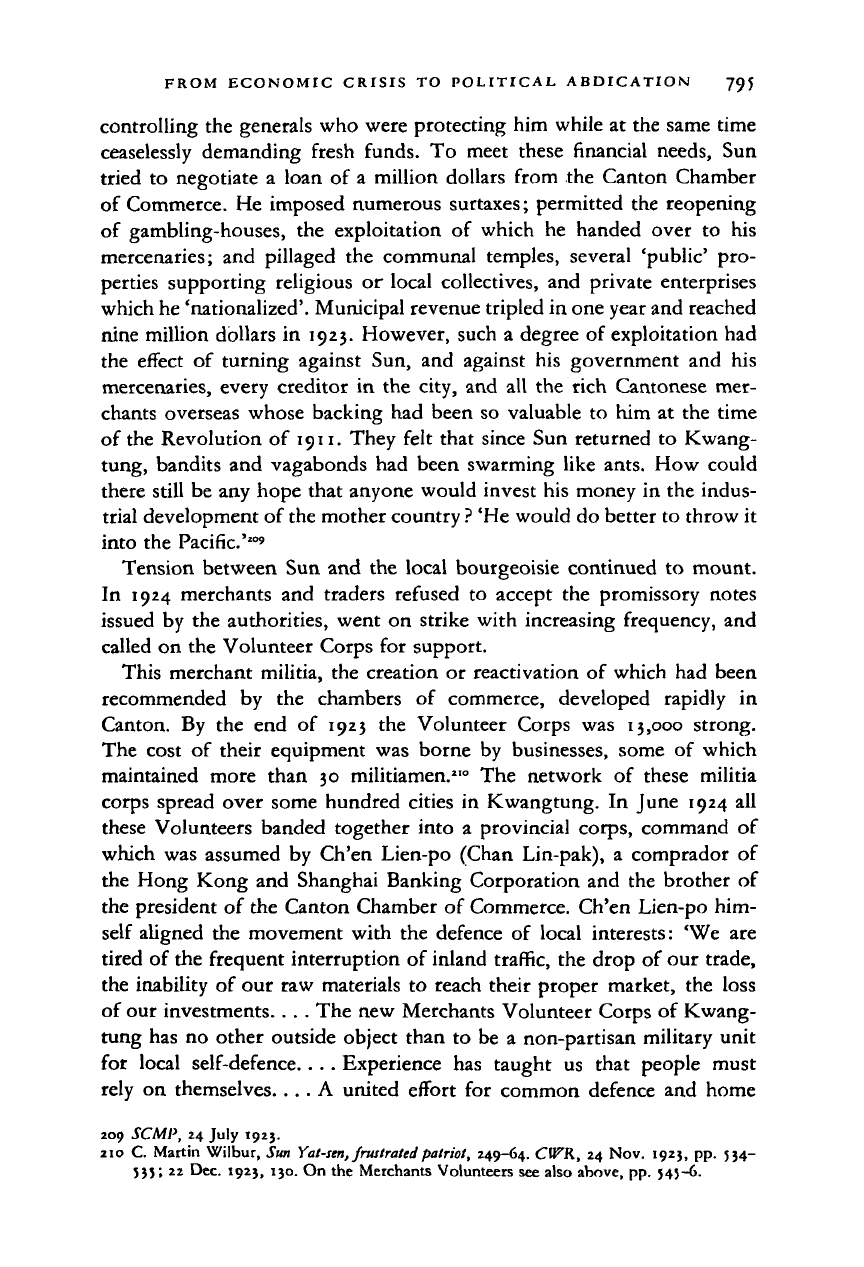
FROM ECONOMIC CRISIS TO POLITICAL ABDICATION 795
controlling
the
generals who were protecting
him
while
at
the same time
ceaselessly demanding fresh funds.
To
meet these financial needs,
Sun
tried
to
negotiate
a
loan
of a
million dollars from
the
Canton Chamber
of Commerce.
He
imposed numerous surtaxes; permitted
the
reopening
of gambling-houses,
the
exploitation
of
which
he
handed over
to his
mercenaries;
and
pillaged
the
communal temples, several 'public'
pro-
perties supporting religious
or
local collectives,
and
private enterprises
which he 'nationalized'. Municipal revenue tripled
in
one year and reached
nine million dollars
in
1923. However, such
a
degree
of
exploitation
had
the effect
of
turning against
Sun, and
against
his
government
and his
mercenaries, every creditor
in the
city,
and all the
rich Cantonese
mer-
chants overseas whose backing
had
been
so
valuable
to him at the
time
of the Revolution
of
1911.
They felt that since
Sun
returned
to
Kwang-
tung, bandits
and
vagabonds
had
been swarming like ants.
How
could
there still
be
any hope that anyone would invest
his
money
in the
indus-
trial development
of
the mother country
?
'He would
do
better
to
throw
it
into
the
Pacific.'
209
Tension between
Sun and the
local bourgeoisie continued
to
mount.
In
1924
merchants
and
traders refused
to
accept
the
promissory notes
issued
by the
authorities, went
on
strike with increasing frequency,
and
called
on the
Volunteer Corps
for
support.
This merchant militia,
the
creation
or
reactivation
of
which
had
been
recommended
by the
chambers
of
commerce, developed rapidly
in
Canton.
By the end of 1923 the
Volunteer Corps
was
13,000 strong.
The cost
of
their equipment
was
borne
by
businesses, some
of
which
maintained more than
30
militiamen.
110
The
network
of
these militia
corps spread over some hundred cities
in
Kwangtung.
In
June 1924
all
these Volunteers banded together into
a
provincial corps, command
of
which
was
assumed
by
Ch'en Lien-po (Chan Lin-pak),
a
comprador
of
the Hong Kong
and
Shanghai Banking Corporation
and the
brother
of
the president
of
the Canton Chamber
of
Commerce. Ch'en Lien-po
him-
self aligned
the
movement with
the
defence
of
local interests:
'We are
tired
of
the frequent interruption
of
inland traffic,
the
drop
of
our trade,
the inability
of
our
raw
materials
to
reach their proper market,
the
loss
of our investments.
. . . The
new Merchants Volunteer Corps
of
Kwang-
tung
has no
other outside object than
to be a
non-partisan military unit
for local self-defence.
. . .
Experience
has
taught
us
that people must
rely
on
themselves.
... A
united effort
for
common defence
and
home
209 SCMP,
24
July 1923.
210
C.
Martin Wilbur, Sun Yat-sm, frustrated patriot, 249-64.
CWK, 24 Nov.
1923,
pp. 534-
535;
22 Dec.
1923, 130.
On the
Merchants Volunteers
see
also above, pp. J45-6.
Cambridge Histories Online © Cambridge University Press, 2008
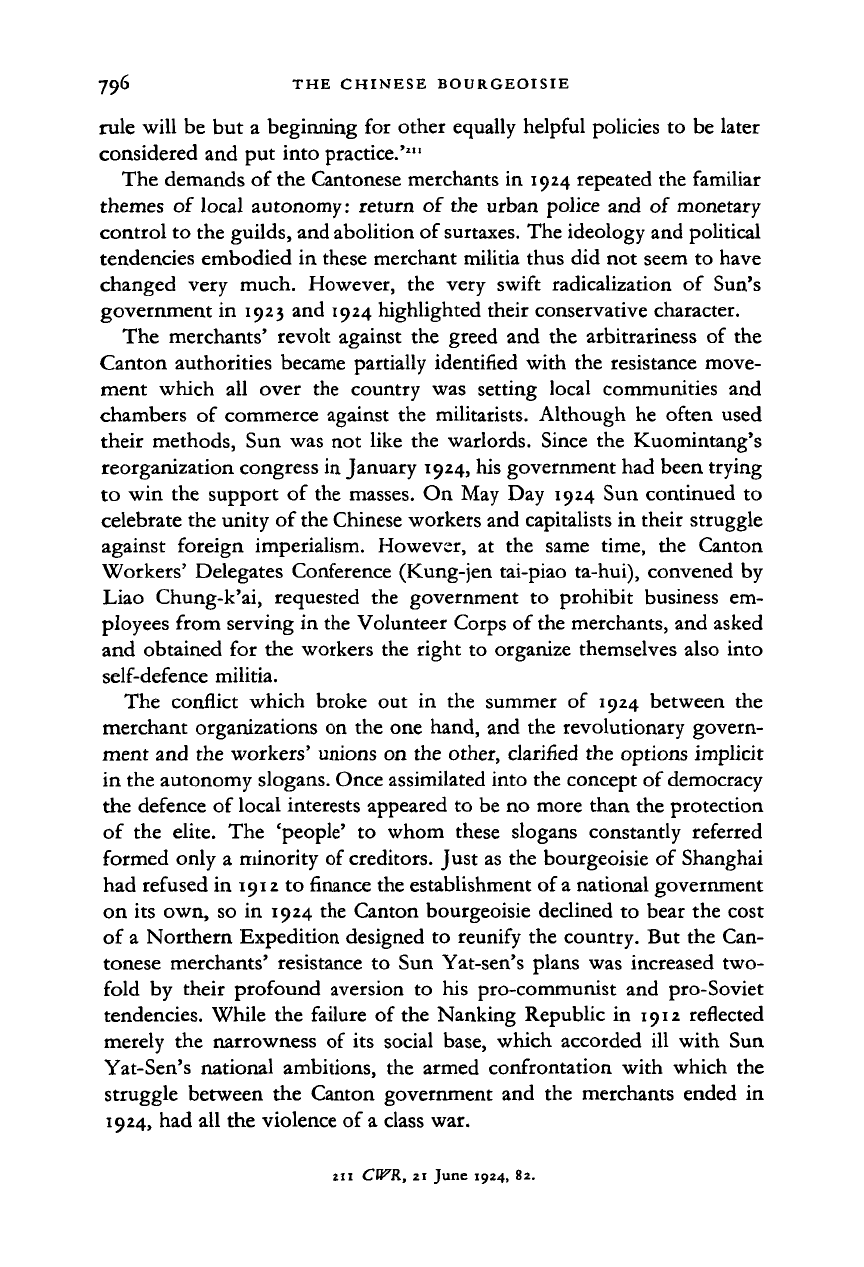
796 THE CHINESE BOURGEOISIE
rule will be but a beginning for other equally helpful policies to be later
considered and put into practice.'
2
"
The demands of the Cantonese merchants in 1924 repeated the familiar
themes of local autonomy: return of the urban police and of monetary
control to the guilds, and abolition of
surtaxes.
The ideology and political
tendencies embodied in these merchant militia thus did not seem to have
changed very much. However, the very swift radicalization of Sun's
government in 1923 and 1924 highlighted their conservative character.
The merchants' revolt against the greed and the arbitrariness of the
Canton authorities became partially identified with the resistance move-
ment which all over the country was setting local communities and
chambers of commerce against the militarists. Although he often used
their methods, Sun was not like the warlords. Since the Kuomintang's
reorganization congress in January 1924, his government had been trying
to win the support of the masses. On May Day 1924 Sun continued to
celebrate the unity of the Chinese workers and capitalists in their struggle
against foreign imperialism. However, at the same time, the Canton
Workers' Delegates Conference (Kung-jen tai-piao ta-hui), convened by
Liao Chung-k'ai, requested the government to prohibit business em-
ployees from serving in the Volunteer Corps of the merchants, and asked
and obtained for the workers the right to organize themselves also into
self-defence militia.
The conflict which broke out in the summer of 1924 between the
merchant organizations on the one hand, and the revolutionary govern-
ment and the workers' unions on the other, clarified the options implicit
in the autonomy slogans. Once assimilated into the concept of democracy
the defence of local interests appeared to be no more than the protection
of the elite. The 'people' to whom these slogans constantly referred
formed only a minority of creditors. Just as the bourgeoisie of Shanghai
had refused in 1912 to finance the establishment of
a
national government
on its own, so in 1924 the Canton bourgeoisie declined to bear the cost
of a Northern Expedition designed to reunify the country. But the Can-
tonese merchants' resistance to Sun Yat-sen's plans was increased two-
fold by their profound aversion to his pro-communist and pro-Soviet
tendencies. While the failure of the Nanking Republic in 1912 reflected
merely the narrowness of its social base, which accorded ill with Sun
Yat-Sen's national ambitions, the armed confrontation with which the
struggle between the Canton government and the merchants ended in
1924,
had all the violence of a class war.
211 CWR, 21 June 1924, 82.
Cambridge Histories Online © Cambridge University Press, 2008
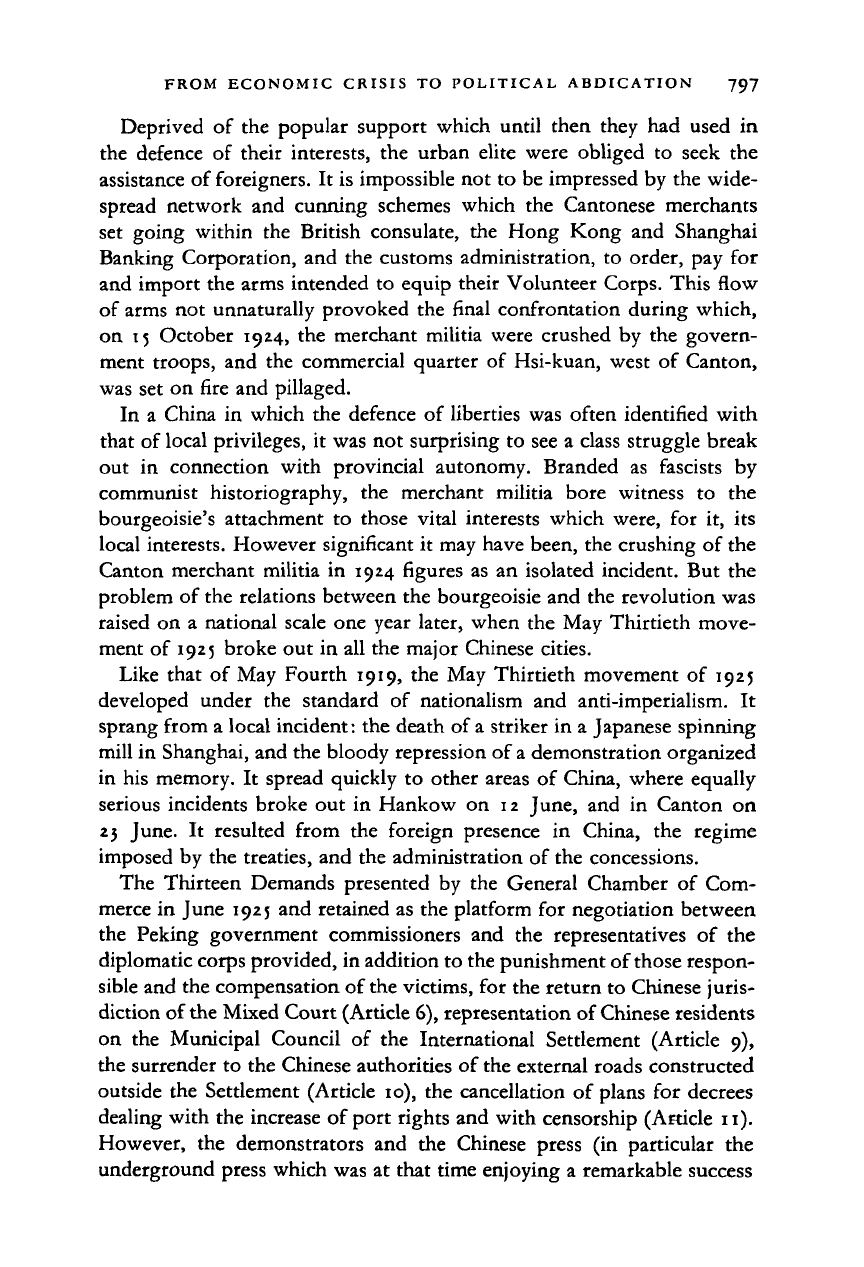
FROM ECONOMIC CRISIS TO POLITICAL ABDICATION 797
Deprived of the popular support which until then they had used in
the defence of their interests, the urban elite were obliged to seek the
assistance of foreigners. It is impossible not to be impressed by the wide-
spread network and cunning schemes which the Cantonese merchants
set going within the British consulate, the Hong Kong and Shanghai
Banking Corporation, and the customs administration, to order, pay for
and import the arms intended to equip their Volunteer Corps. This flow
of arms not unnaturally provoked the final confrontation during which,
on 15 October 1924, the merchant militia were crushed by the govern-
ment troops, and the commercial quarter of Hsi-kuan, west of Canton,
was set on fire and pillaged.
In a China in which the defence of liberties was often identified with
that of local privileges, it was not surprising to see a class struggle break
out in connection with provincial autonomy. Branded as fascists by
communist historiography, the merchant militia bore witness to the
bourgeoisie's attachment to those vital interests which were, for it, its
local interests. However significant it may have been, the crushing of the
Canton merchant militia in 1924 figures as an isolated incident. But the
problem of the relations between the bourgeoisie and the revolution was
raised on a national scale one year later, when the May Thirtieth move-
ment of 1925 broke out in all the major Chinese cities.
Like that of May Fourth 1919, the May Thirtieth movement of 1925
developed under the standard of nationalism and anti-imperialism. It
sprang from a local incident: the death of
a
striker in a Japanese spinning
mill in Shanghai, and the bloody repression of
a
demonstration organized
in his memory. It spread quickly to other areas of China, where equally
serious incidents broke out in Hankow on 12 June, and in Canton on
23 June. It resulted from the foreign presence in China, the regime
imposed by the treaties, and the administration of the concessions.
The Thirteen Demands presented by the General Chamber of Com-
merce in June 1925 and retained as the platform for negotiation between
the Peking government commissioners and the representatives of the
diplomatic corps provided, in addition to the punishment of those respon-
sible and the compensation of the victims, for the return to Chinese juris-
diction of the Mixed Court (Article 6), representation of Chinese residents
on the Municipal Council of the International Settlement (Article 9),
the surrender to the Chinese authorities of the external roads constructed
outside the Settlement (Article 10), the cancellation of plans for decrees
dealing with the increase of port rights and with censorship (Article 11).
However, the demonstrators and the Chinese press (in particular the
underground press which was at that time enjoying a remarkable success
Cambridge Histories Online © Cambridge University Press, 2008
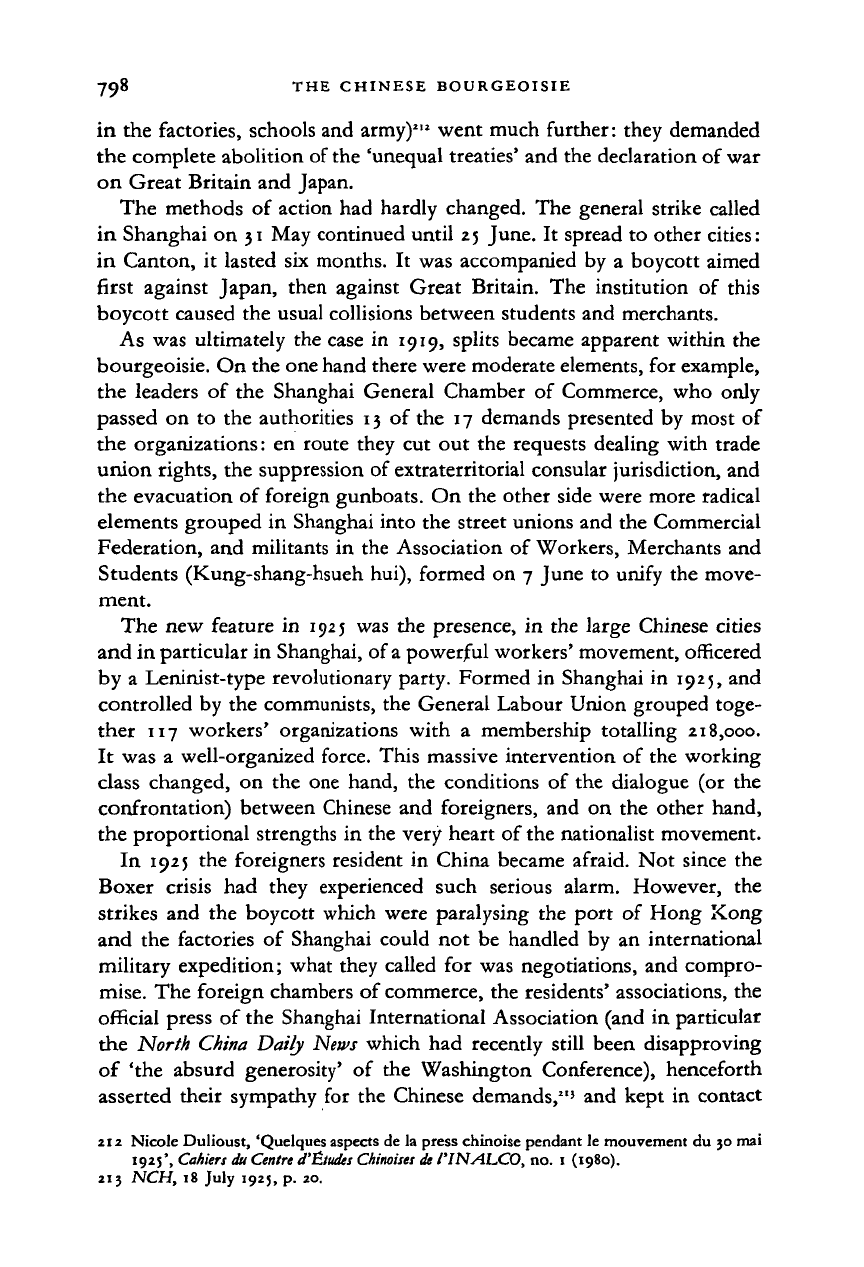
798 THE CHINESE BOURGEOISIE
in the factories, schools and army)
212
went much further: they demanded
the complete abolition of the 'unequal treaties' and the declaration of war
on Great Britain and Japan.
The methods of action had hardly changed. The general strike called
in Shanghai on 31 May continued until 2 5 June. It spread to other cities:
in Canton, it lasted six months. It was accompanied by a boycott aimed
first against Japan, then against Great Britain. The institution of this
boycott caused the usual collisions between students and merchants.
As was ultimately the case in 1919, splits became apparent within the
bourgeoisie. On the one hand there were moderate elements, for example,
the leaders of the Shanghai General Chamber of Commerce, who only
passed on to the authorities 13 of the 17 demands presented by most of
the organizations: en route they cut out the requests dealing with trade
union rights, the suppression of extraterritorial consular jurisdiction, and
the evacuation of foreign gunboats. On the other side were more radical
elements grouped in Shanghai into the street unions and the Commercial
Federation, and militants in the Association of Workers, Merchants and
Students (Kung-shang-hsueh hui), formed on 7 June to unify the move-
ment.
The new feature in 1925 was the presence, in the large Chinese cities
and in particular in Shanghai, of a powerful workers' movement, officered
by a Leninist-type revolutionary party. Formed in Shanghai in 1925, and
controlled by the communists, the General Labour Union grouped toge-
ther 117 workers' organizations with a membership totalling 218,000.
It was a well-organized force. This massive intervention of the working
class changed, on the one hand, the conditions of the dialogue (or the
confrontation) between Chinese and foreigners, and on the other hand,
the proportional strengths in the very heart of the nationalist movement.
In 1925 the foreigners resident in China became afraid. Not since the
Boxer crisis had they experienced such serious alarm. However, the
strikes and the boycott which were paralysing the port of Hong Kong
and the factories of Shanghai could not be handled by an international
military expedition; what they called for was negotiations, and compro-
mise.
The foreign chambers of commerce, the residents' associations, the
official press of the Shanghai International Association (and in particular
the North China Daily News which had recently still been disapproving
of 'the absurd generosity' of the Washington Conference), henceforth
asserted their sympathy for the Chinese demands,
21
' and kept in contact
zi2 Nicole Dulioust, 'Quelques aspects de la press chinoise pendant le mouvement du 30 mai
1925',
Cahiers
du
Centre
d'Etudes
Chinoises de
1'INALCO, no. 1 (1980).
213 NCH, 18 July 1925, p. 20.
Cambridge Histories Online © Cambridge University Press, 2008
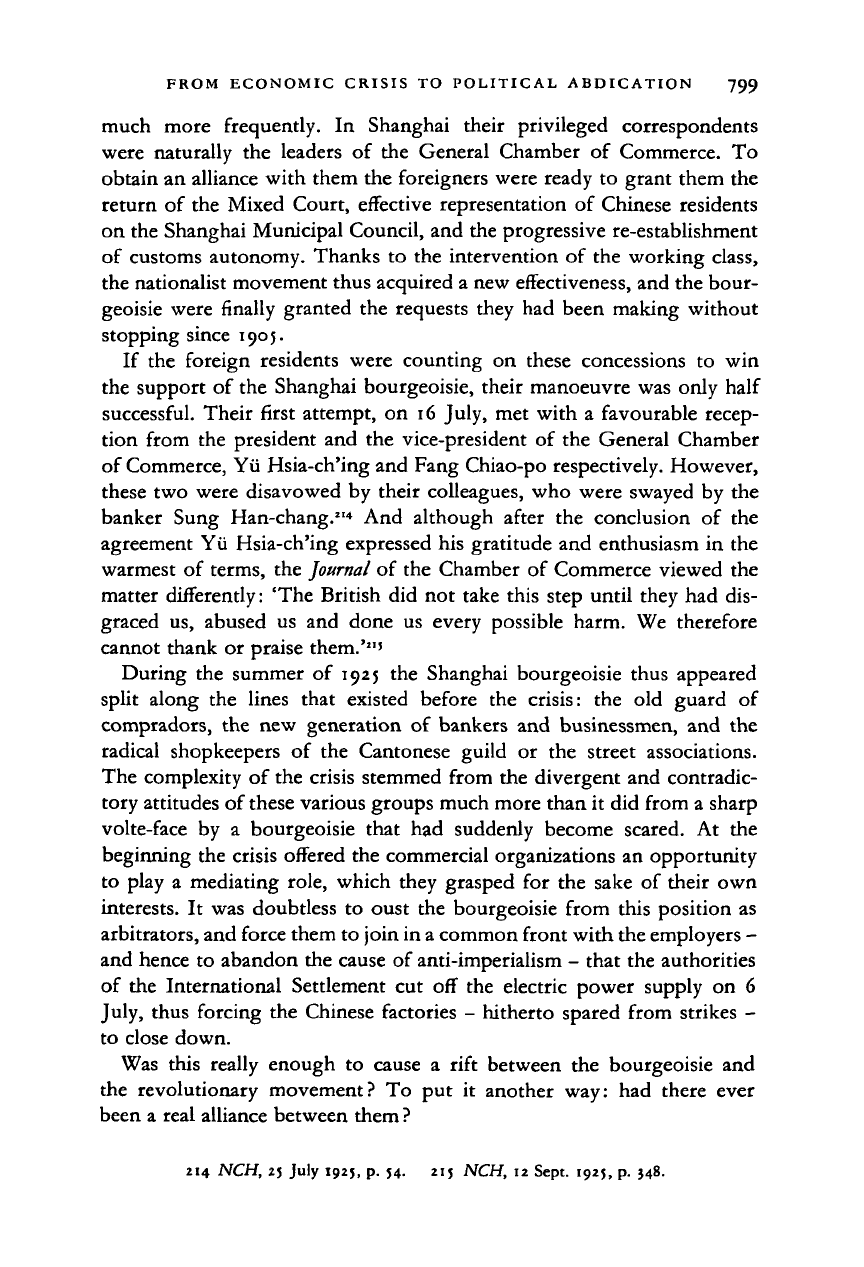
FROM ECONOMIC CRISIS TO POLITICAL ABDICATION 799
much more frequently. In Shanghai their privileged correspondents
were naturally the leaders of the General Chamber of Commerce. To
obtain an alliance with them the foreigners were ready to grant them the
return of the Mixed Court, effective representation of Chinese residents
on the Shanghai Municipal Council, and the progressive re-establishment
of customs autonomy. Thanks to the intervention of the working class,
the nationalist movement thus acquired a new effectiveness, and the bour-
geoisie were finally granted the requests they had been making without
stopping since 1905.
If the foreign residents were counting on these concessions to win
the support of the Shanghai bourgeoisie, their manoeuvre was only half
successful. Their first attempt, on 16 July, met with a favourable recep-
tion from the president and the vice-president of the General Chamber
of Commerce, Yii Hsia-ch'ing and Fang Chiao-po respectively. However,
these two were disavowed by their colleagues, who were swayed by the
banker Sung Han-chang.
2
'
4
And although after the conclusion of the
agreement Yii Hsia-ch'ing expressed his gratitude and enthusiasm in the
warmest of terms, the
Journal
of the Chamber of Commerce viewed the
matter differently: 'The British did not take this step until they had dis-
graced us, abused us and done us every possible harm. We therefore
cannot thank or praise them.'"'
During the summer of 1925 the Shanghai bourgeoisie thus appeared
split along the lines that existed before the crisis: the old guard of
compradors, the new generation of bankers and businessmen, and the
radical shopkeepers of the Cantonese guild or the street associations.
The complexity of the crisis stemmed from the divergent and contradic-
tory attitudes of these various groups much more than it did from a sharp
volte-face by a bourgeoisie that had suddenly become scared. At the
beginning the crisis offered the commercial organizations an opportunity
to play a mediating role, which they grasped for the sake of their own
interests. It was doubtless to oust the bourgeoisie from this position as
arbitrators, and force them to join in a common front with the employers -
and hence to abandon the cause of anti-imperialism - that the authorities
of the International Settlement cut off the electric power supply on 6
July, thus forcing the Chinese factories - hitherto spared from strikes -
to close down.
Was this really enough to cause a rift between the bourgeoisie and
the revolutionary movement? To put it another way: had there ever
been a real alliance between them
?
214 NCH, 25 July 1925, p. 54. 215 NCH, 12 Sept. 1925,
p.
348.
Cambridge Histories Online © Cambridge University Press, 2008
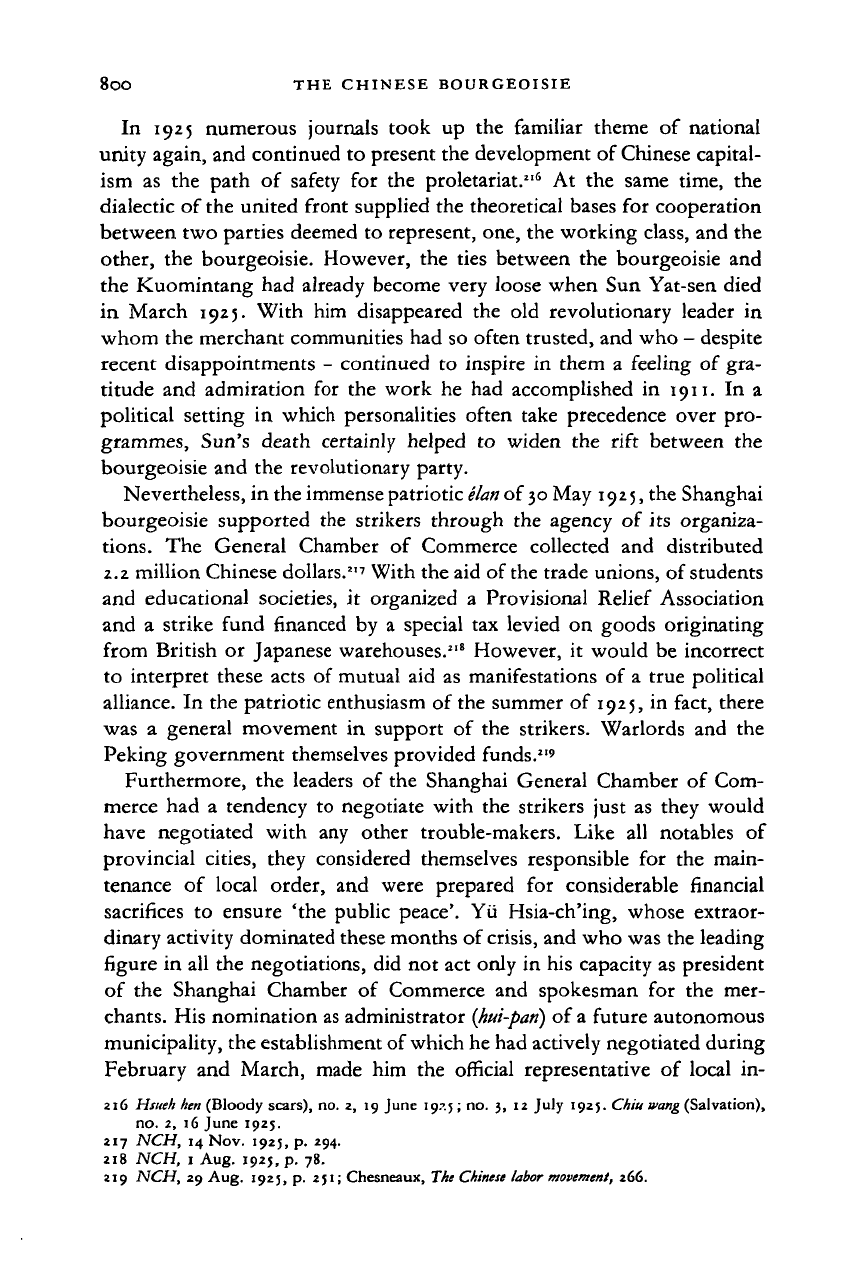
8oO THE CHINESE BOURGEOISIE
In 1925 numerous journals took
up the
familiar theme
of
national
unity again, and continued to present the development of Chinese capital-
ism
as the
path
of
safety
for the
proletariat.
2
'
6
At the
same time,
the
dialectic of the united front supplied the theoretical bases for cooperation
between two parties deemed to represent, one, the working class, and the
other,
the
bourgeoisie. However,
the
ties between the bourgeoisie and
the Kuomintang had already become very loose when Sun Yat-sen died
in March 1925. With him disappeared
the old
revolutionary leader
in
whom the merchant communities had so often trusted, and who
-
despite
recent disappointments
-
continued
to
inspire
in
them
a
feeling
of
gra-
titude and admiration
for the
work
he
had accomplished
in
1911.
In a
political setting
in
which personalities often take precedence over pro-
grammes, Sun's death certainly helped
to
widen
the
rift between
the
bourgeoisie and the revolutionary party.
Nevertheless, in the immense patriotic
elan
of
30
May 1925, the Shanghai
bourgeoisie supported the strikers through the agency
of
its organiza-
tions.
The
General Chamber
of
Commerce collected
and
distributed
2.2 million Chinese dollars.
2
'
7
With the aid of the trade unions, of students
and educational societies,
it
organized
a
Provisional Relief Association
and
a
strike fund financed
by a
special tax levied
on
goods originating
from British
or
Japanese warehouses.
2
'
8
However,
it
would be incorrect
to interpret these acts
of
mutual aid as manifestations
of
a true political
alliance.
In
the patriotic enthusiasm of the summer
of
1925, in fact, there
was
a
general movement
in
support
of
the strikers. Warlords
and the
Peking government themselves provided funds.
21
'
Furthermore,
the
leaders
of
the Shanghai General Chamber
of
Com-
merce had
a
tendency
to
negotiate with the strikers just
as
they would
have negotiated with
any
other trouble-makers. Like
all
notables
of
provincial cities, they considered themselves responsible
for the
main-
tenance
of
local order,
and
were prepared
for
considerable financial
sacrifices
to
ensure 'the public peace'.
Yii
Hsia-ch'ing, whose extraor-
dinary activity dominated these months of
crisis,
and who was the leading
figure in all the negotiations, did not act only in his capacity as president
of the Shanghai Chamber
of
Commerce
and
spokesman
for the
mer-
chants. His nomination as administrator
{hui-pati)
of a future autonomous
municipality, the establishment of which he had actively negotiated during
February
and
March, made him
the
official representative
of
local
in-
216 Hsueh hen (Bloody scars), no.
2,
19 June 19.T5; no.
3,
12 July 1925. Chiu
wang
(Salvation),
no.
2,
16 June 1925.
217
NCH,
14 Nov. 1925, p. 294.
218
NCH,
1 Aug. J925, p. 78.
219
NCH,
29 Aug. 1925,
p.
251; Chesneaux, The
Chinese
labor
movement,
266.
Cambridge Histories Online © Cambridge University Press, 2008
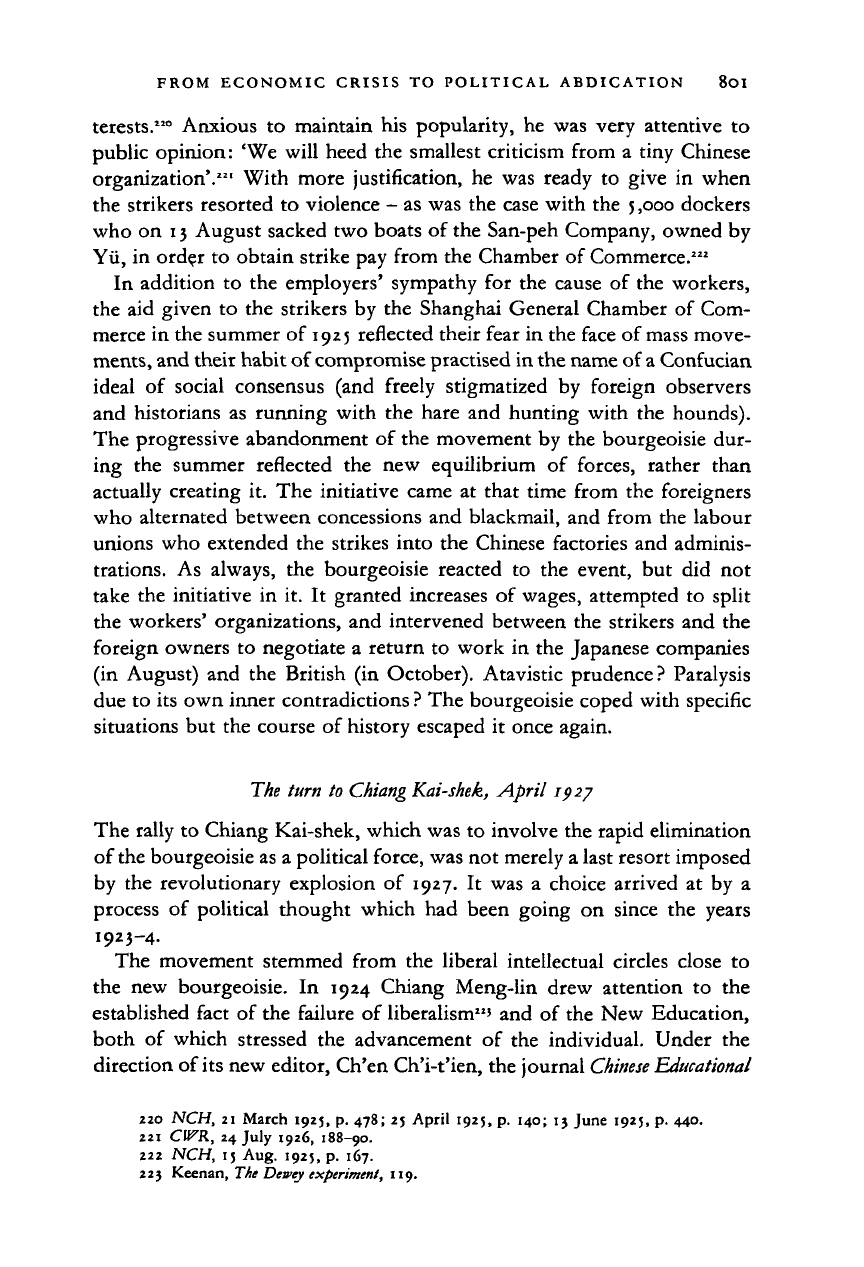
FROM ECONOMIC CRISIS TO POLITICAL ABDICATION 8oi
terests.
220
Anxious
to
maintain
his
popularity,
he
was very attentive
to
public opinion: 'We will heed
the
smallest criticism from
a
tiny Chinese
organization'.
221
With more justification,
he was
ready
to
give
in
when
the strikers resorted
to
violence
-
as was the case with the
5,000
dockers
who
on
13 August sacked two boats
of
the San-peh Company, owned
by
Yii,
in
order
to
obtain strike pay from the Chamber
of
Commerce.
222
In addition
to the
employers' sympathy
for the
cause
of
the workers,
the
aid
given
to the
strikers
by
the Shanghai General Chamber
of
Com-
merce in the summer
of
1925 reflected their fear in the face
of
mass move-
ments, and their habit of compromise practised in the name of a Confucian
ideal
of
social consensus
(and
freely stigmatized
by
foreign observers
and historians
as
running with
the
hare
and
hunting with
the
hounds).
The progressive abandonment
of
the movement by the bourgeoisie dur-
ing
the
summer reflected
the new
equilibrium
of
forces, rather than
actually creating
it.
The initiative came
at
that time from
the
foreigners
who alternated between concessions and blackmail, and from the labour
unions who extended
the
strikes into
the
Chinese factories and adminis-
trations.
As
always,
the
bourgeoisie reacted
to the
event,
but did not
take the initiative
in it. It
granted increases
of
wages, attempted
to
split
the workers' organizations,
and
intervened between the strikers
and the
foreign owners
to
negotiate
a
return
to
work
in
the Japanese companies
(in August)
and the
British
(in
October). Atavistic prudence? Paralysis
due
to
its own inner contradictions
?
The bourgeoisie coped with specific
situations
but
the course
of
history escaped
it
once again.
The turn to Chiang Kai-shek, April 1927
The rally
to
Chiang Kai-shek, which was
to
involve the rapid elimination
of the bourgeoisie as a political force, was not merely a last resort imposed
by
the
revolutionary explosion
of
1927.
It
was
a
choice arrived
at by a
process
of
political thought which
had
been going
on
since
the
years
1923-4.
The movement stemmed from
the
liberal intellectual circles close
to
the
new
bourgeoisie.
In
1924 Chiang Meng-lin drew attention
to the
established fact
of
the failure
of
liberalism
22
'
and of
the New Education,
both
of
which stressed
the
advancement
of the
individual. Under
the
direction of its new editor, Ch'en Ch'i-t'ien, the journal
Chinese Educational
220
NCH, 21
March 1925,
p.
478;
25
April 1925,
p.
140; 13 June 1925,
p.
440.
221
CWR,
24 July 1926, 188-90.
222
NCH,
15 Aug. 1925, p. 167.
22} Keenan, The
Dewey
experiment,
119.
Cambridge Histories Online © Cambridge University Press, 2008
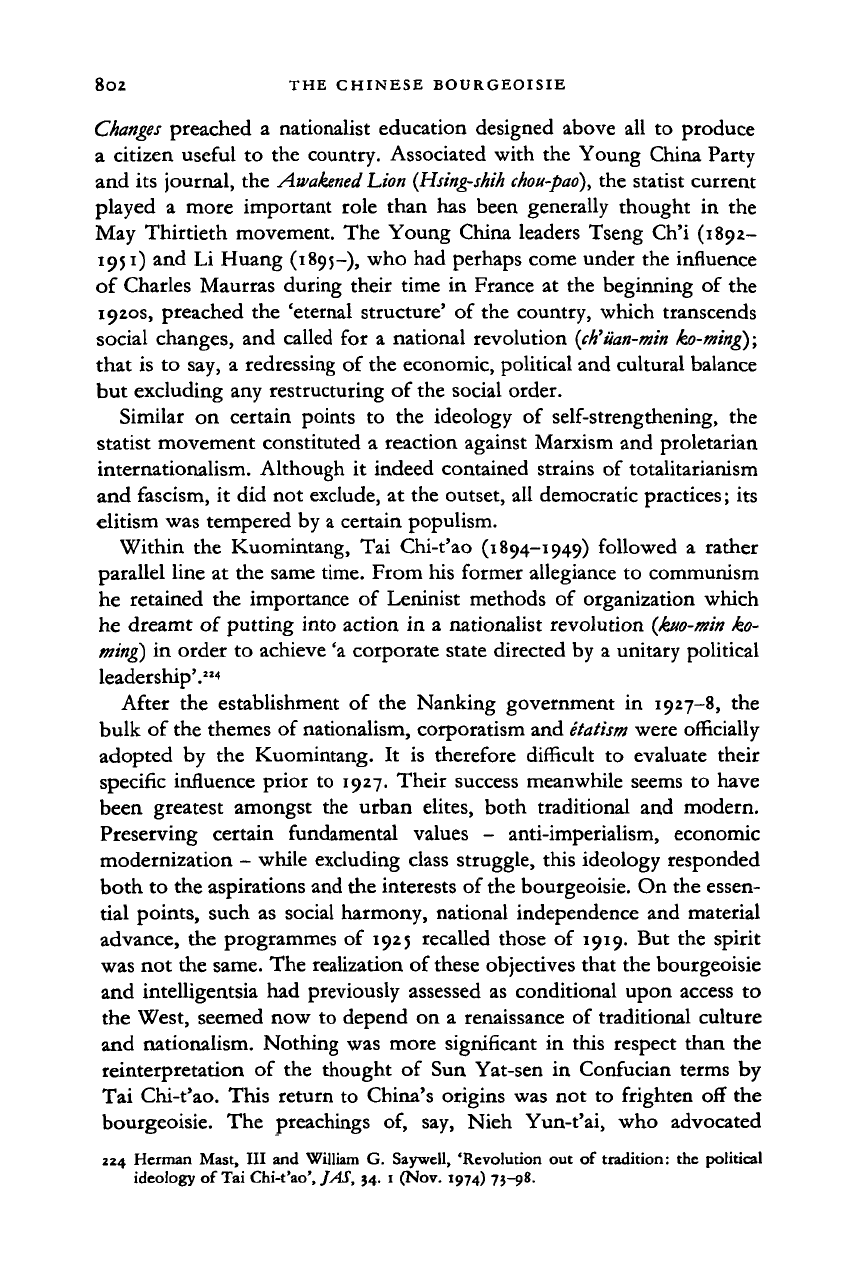
8O2 THE CHINESE BOURGEOISIE
Changes
preached
a
nationalist education designed above
all to
produce
a citizen useful
to the
country. Associated with
the
Young China Party
and
its
journal,
the
Awakened Lion (Hsing-shih
chou-pao),
the
statist current
played
a
more important role than
has
been generally thought
in the
May Thirtieth movement.
The
Young China leaders Tseng
Ch'i
(1892-
1951)
and Li
Huang (1895-), who
had
perhaps come under
the
influence
of Charles Maurras during their time
in
France
at the
beginning
of the
1920s, preached
the
'eternal structure'
of the
country, which transcends
social changes,
and
called
for a
national revolution
(ch'iian-min
ko-ming);
that
is to
say,
a
redressing
of
the economic, political and cultural balance
but excluding
any
restructuring
of
the social order.
Similar
on
certain points
to the
ideology
of
self-strengthening,
the
statist movement constituted
a
reaction against Marxism
and
proletarian
internationalism. Although
it
indeed contained strains
of
totalitarianism
and fascism,
it did not
exclude,
at the
outset,
all
democratic practices;
its
elitism was tempered by a certain populism.
Within
the
Kuomintang,
Tai
Chi-t'ao (1894-1949) followed
a
rather
parallel line
at the
same time. From his former allegiance
to
communism
he retained
the
importance
of
Leninist methods
of
organization which
he dreamt
of
putting into action
in a
nationalist revolution
(kuo-min
ko-
ming)
in
order
to
achieve
'a
corporate state directed
by a
unitary political
leadership'.""
After
the
establishment
of the
Nanking government
in
1927-8,
the
bulk
of
the themes
of
nationalism, corporatism and
etatism
were officially
adopted
by the
Kuomintang.
It is
therefore difficult
to
evaluate their
specific influence prior
to
1927. Their success meanwhile seems
to
have
been greatest amongst
the
urban elites, both traditional
and
modern.
Preserving certain fundamental values
-
anti-imperialism, economic
modernization
-
while excluding class struggle, this ideology responded
both
to
the aspirations and the interests
of
the bourgeoisie.
On
the essen-
tial points, such
as
social harmony, national independence
and
material
advance,
the
programmes
of
1925 recalled those
of
1919.
But the
spirit
was
not
the same. The realization
of
these objectives that the bourgeoisie
and intelligentsia
had
previously assessed
as
conditional upon access
to
the West, seemed
now to
depend
on a
renaissance
of
traditional culture
and nationalism. Nothing
was
more significant
in
this respect than
the
reinterpretation
of the
thought
of Sun
Yat-sen
in
Confucian terms
by
Tai Chi-t'ao. This return
to
China's origins
was not to
frighten
off the
bourgeoisie.
The
preachings
of, say,
Nieh Yun-t'ai,
who
advocated
224 Herman Mast,
III and
William
G.
Sajrwell, 'Revolution
out of
tradition:
the
political
ideology
of
Tai Chi-t'ao',
JAS, 34. 1 (Nov.
1974) 75-98.
Cambridge Histories Online © Cambridge University Press, 2008
